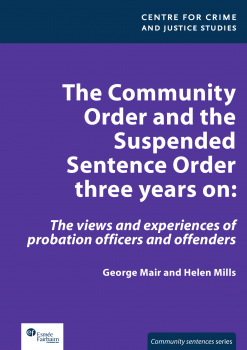The Community Order and the Suspended Sentence Order Three Years On: The views and experiences of probation officers and offenders

Government attempts to slow a rapidly rising prison population by a reformed, and credible, community sentences framework has largely failed, according to a report published by the Centre for Crime and Justice Studies. Indeed there is evidence that the Community Orders and Suspended Sentence Orders, which came into effect in April 2005, are contributing to the rise in prison numbers, rather than helping to arrest its growth.
The report - The Community Order and the Suspended Sentence Order three years on - independently assesses the impact of the Community Order and Suspended Sentence Order three years on from their implementation. Its findings are based on analysis of government statistics about the use of the two orders and interviews with 25 probation staff and 16 people subject to the orders.
Some of the report's key findings are:
- There was a fifteen-fold increase in the use of the Suspended Sentence Order in its first year and a twenty four-fold increase in the three years to 2008. Half of all Suspended Sentence Orders handed out in the magistrates' courts are for the less serious `summary' offences, suggesting that the Orders are being used too often and inappropriately.
- Both the Community Order and the Suspended Sentence Order appear to be getting tougher and more punitive. Use of unpaid work and curfews has been growing. Both unpaid work and curfew requirements share punishment as a main sentencing purpose, suggesting an increased resort to more punitive requirements.
- There is no evidence that the Community Order or Suspended Sentence Order are reducing the use of short-term custodial sentences or tackling `uptariffing'. The prison population has continued to grow alongside the increasing use of the two Orders.
- There is evidence that the sentences are displacing fines, rather than prison.
Helen Mills and and aco-author of the report said:
`In their ongoing drive for effective management the government maybe undermining a style of work that was valued by those probation officers and people on orders we spoke to.'
Richard Garside, director of the Centre for Crime and Justice Studies said:
`Most people would no doubt prefer a spell of community service to six months in Holloway or Wormwood Scrubs. But the current community sentencing framework appears to be contributing to ongoing prison expansion, not slowing or reversing its growth. The question is, are community sentences part of the solution, or are they part of the problem?'